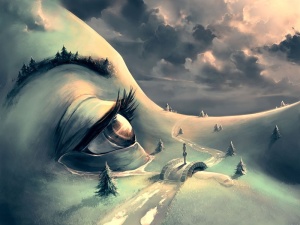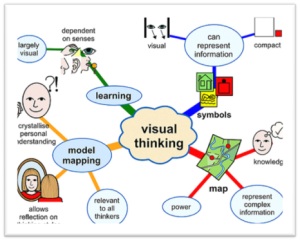Pieces of us are inadvertently left behind as we grow older. We adapt or semi-adapt to the world’s uniform oneness. Or so we tell ourselves.
I am a visual person.
As a child, I was a visual learner. I suppose this is true for all in childhood, the reason we start with picture books. But I think it went past childhood for me. Even when using text books, I always learned best from diagrams, charts, maps, images — the pictures in my mind immediate and striking.
I was reminded of this when sitting in my son’s classroom recently for the back-to-school meeting — an event filled with the teacher’s learning philosophy, something made abundantly clear in the papers sent home. Still, there I sat in my son’s chair, at his desk, hoping to glean the un-gleanable.
As always, I fell adrift in a daze of formalities until two words snapped me right back: visual learner … visual … learner — a phrase describing a way of study.
Suppressed memories came back alive: the young self with all those picture books. Photographs. Images of every color. And the question: How do visual learners survive those heavy text books in college? Maybe that’s why we move to PowerPoint, diagrams and charts. Not only as a mode of presentation, but for our own benefit. For learning.
And how does a visual learner become a veracious reader? I suppose the mind adjusts and the thirst for imagery is replaced by language in its most beautiful form. Descriptive language.
No wonder, then, Description is my favorite text type. Something the non-visual learner might skim through in a book, I delight in reading. And writing.
Here’s one such Description from Steinbeck’s Of Mice and Men, implying the character’s state, in the big picture, but also offering vivid imagery for the mind’s eye:
There is a path through the willows and among the sycamores, a path beaten hard by boys coming down from the ranches to swim in the deep pool, and beaten hard by tramps who come wearily down from the highway in the evening to jungle-up near the water.
Those words, written just so, conjure up a spectacular image, and I am there, with those boys and those tramps on that very path.
And so we adapt, or do we?
—-
Images: thestudyguru.com, forum.xcitefun.net








I love it when descriptions can paint an image in my mind. I enjoy reading, but that’s when reading is special. Great post.
Great descriptions translate to great images. Thank you, Dan.
There are all sorts of learning modalities. I think the current theory says 8, but I’m probably wrong about that.
Amazing isn’t it, Liz? And while the teachers talk about it, they continue teaching more or less one modality. I guess the info given at back-to-school night is for the parents and not representative of their way of doing things. Thanks for reading.
Nice post, Sylvia! Teaching anatomy to medical students taught me that there were many unique ways of learning and I had to help each student find which was best for them. I am a visual learner but I visualize in words – I love to draw pictures with words!
Indeed, Noelle, there are as many ways of learning as there are people in the world, but of course the schools have to stop somewhere. I imagine you as a great professor. Would have loved to have sat in one of your classes. Thank you for stopping by.
I am a visual learner, as well as I need to see “the big picture.” Like you, I need to have a picture drawn with words. I still get lost in parts and pieces unless I see the pattern and the overall scene. I truly need to be able to visualize what I’m writing or I’m sunk. I’m glad that schools are finally learning that kids learn in different ways! Did you feel that when you were in your son’s class?
Thank you, Gwynn. A picture drawn with words helps a lot. The schools, while presenting this idea, are really not teaching kids based on their way of learning, say auditory learners separate from visual learners, etc. They have their curriculum and way of teaching, and that’s what they stick with. I imagine it would be madness accommodating everyone. The presentation was more or less for the parents, but it’s good to know they are circulating the idea.
I love it. Yes, visuals are wonderful teaching tools. When we don’t have an actual picture to look at, we can conjure one up from lovely descriptions, like Steinbeck’s.
I would imagine, Mary, that for the music lover in you, visuals and sound make a world of difference. Art is amazing, and is what saves us, I feel, from the madness of the world. :) Thank you.
Great topic, Silvia. I am not a visual learner; I can barely read a digram or illustrated chart, and never liked comics (other than Archie) as a kid. I need everyting in writing. I suppose if I was placed in solitary for several years with only diagrams, I’d adapt but I don’t want to test that theory!
That said, following bloggers who specialize in photography and some art genres has definitely broadened my visual perception.
I’m glad students are assessed for their differences in learning styles because it affects them the rest if theur lives.
I really am not one for comics either, come to think of it. But illustrations and the like help a lot. No, I wouldn’t want you testing the solitary theory either. :) Interesting, though, how our perception is constantly broadened. I feel the same way about many new blogs I come in contact with, every-day stories painted with words. Thanks, Sammy.
Great post, indeed, Silvia! I am very much visual, and especially spatial with limited attention to color unless I am thinking of botany, landscapes, and using a camera with attention to color nuances mornings or sunsets.. Your post also makes me think of how useful auditory imaging is important to me as, for example, I rehearse what I hear and that helps fix it in memory. Sometimes I have an emotional feeling about a past event and a lyric tune comes to mind, even without the words immediately remembered. Then, I feed Google some words and a complete stanza will appear, such as “All things bright and beautiful.”
Spatial imaging in my mind is very useful, as I can peek at a road map once and continue driving to a given destination. These days, Geographic Positioning Systems (GPS) rob you of your natural intelligence, as they show a tiny portion of a path you are traveling, but GPS’s can deprive your of thinking about North, South, East, and West, and the directions from which the sun rays greet you at different times of the day. In ancient times, sailors could watch the stars in the sky, and travel without a compass simply by knowing the constellations. That would result in traveling in a straight line over many miles.
Thank you, Joseph, for the wonderfully detailed post here. It’s nice to see that we allow ourselves the time to express what we think in writing, and not just rush, rush, rush, as so much of today’s communication has become. I love your GPS analogy. Technology can be very helpful and at the same time it can rob us of natural learning ways, going way back to the sailors of years past and so many others before them. People were forced to learn, hence they were better readers, observers, and they likely felt more, as learning creates feelings. I wonder what’s going to become of our very race in the many years to come. So much was added to our lives through technology, yet much was obliterated.
Hi Silvia – first off … I’m sorry I didn’t carry on with the picture bloghop – I can never get my head into them .. but did love seeing the bloggers who entered – Susan, yourself …
I’m not sure how I learn … I need to write things down, but need to feel the concept of what I’m writing … so there’s some visualisation there. I’ve read some interesting books over the summer … which seem to all interlink ideas … I think I have a cobweb brain!
Cheers Hilary
Not a problem, Hilary. You know how this works, we do what we can and move on from there. Learning through writing is, I think, an excellent way. Our minds can only take in so much at a time. I think your stile is great. Thank you so much for visiting.
Silvia, I am intrigued by your statement that links the sequence, . . . to learn . . . better readers . . . and they likely felt more.” I think this is a process of major significance and is explained by neuroscientists, when learning opens up totally new powers of intelligence, and may also have positive impact on the DNA of nerve cells of the brain. Kathryn Lane Rossi and Ernest Lawrence Rossi wrote on this in their 2013 book.
How very interesting, Joseph. Thank you for sharing, and the info on the book. I think when we learn through observation — when we watch the world on our own terms, without help from devices, GPS and the like — we become more in tune with nature, we give our minds the time to take it all in, we are in a way closer to nature. The more connected we are to the rest of the living space and things around us, the happier we are, don’t you think? Hence we feel more. Happiness is feeling. This natural connection, then, brings us joy. I know when I’m at the beach or go on a hike, just walking like I was meant to, without tech distractions, I learn from nature and I feel it, and I am happy. Thank you, Joseph. I am grateful for our ‘chats.”
Hi Silvia, I enjoyed this post thank you. I like it when images come to mind. For me it means that the writer/musician/artist pricks my imagination. When checking out graphs or e.g. maps I’m aware that another part of my brain comes into play when I use effort to make sense of it. It’s great when we utilise both parts of the brain left & right hemisphere – and, I guess, the spaces in between! Have a great weekend!